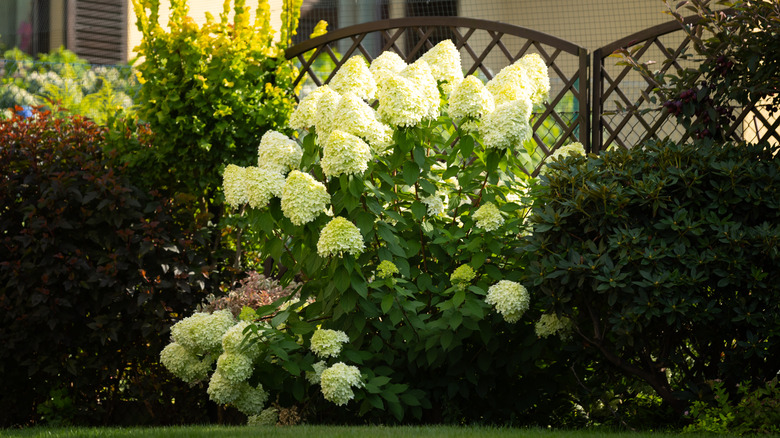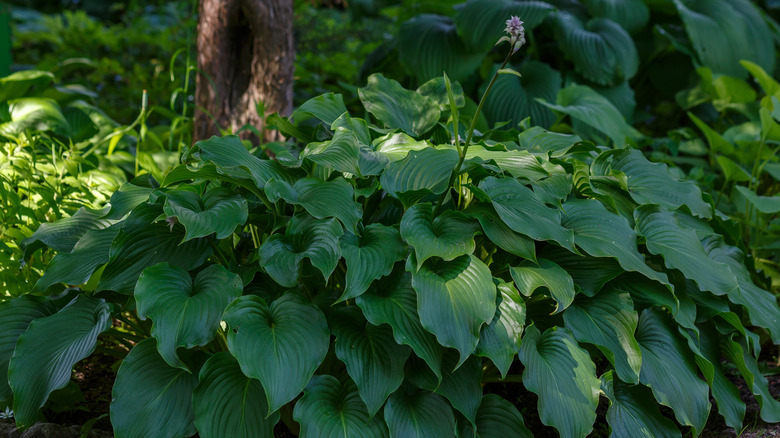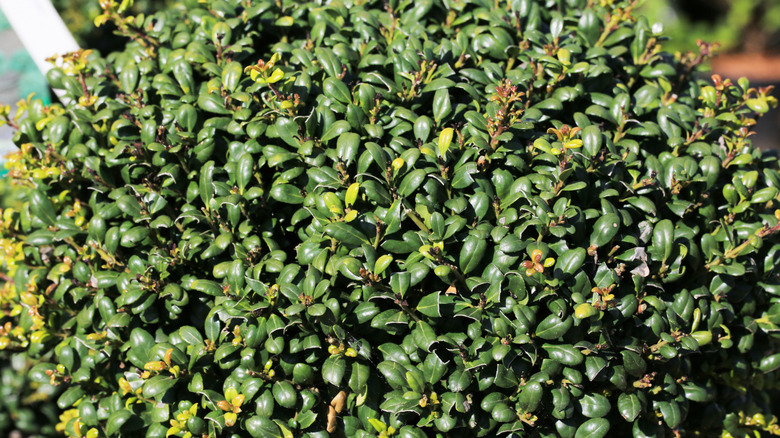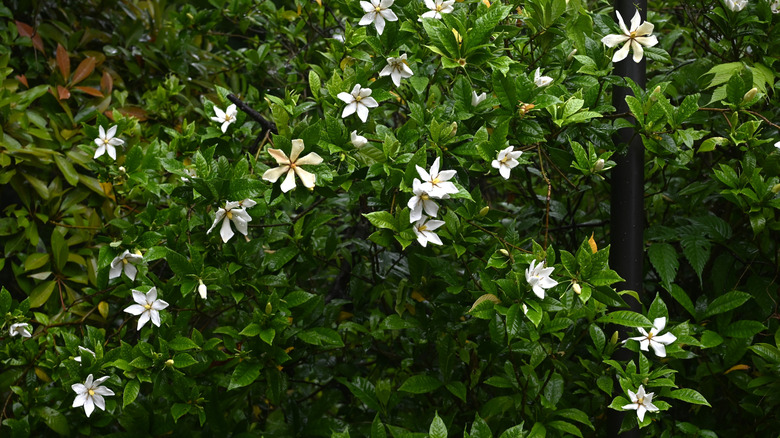8 Of The Best Companion Plants To Grow Near Hydrangeas For A Stunning Garden
Who can resist the massive blooms of hydrangeas? While these gorgeous shrubs look stunning on their own as statement plants, they can be even more charming when paired with other species that grow in similar conditions. When trying to decide on the ideal companion for your hydrangea, it's important to know which species you're growing. Not only are different types of hydrangeas hardy in different zones, but they also have different sunlight and moisture needs.
While bigleaf hydrangeas (Hydrangea macrophylla) require partial to deep shade and moist soil and should be paired with plants that need shade, oakleaf hydrangeas (Hydrangea quercifolia) are perfectly happy in full sun and even have some drought tolerance. Similarly, while bigleaf hydrangeas can only grow in USDA Hardiness Zones 6 and higher, growers in areas as cold as zone 3 can enjoy panicle hydrangeas (Hydrangea paniculata).
Hydrangeas come in a wide range of sizes as well, with some panicle hydrangeas reaching as large as 25 feet tall and wide, while other hydrangeas stay under 5 feet. This means some extra research is required to find the best hydrangea (and hydrangea companion) for your yard, but almost everyone can find at least something that is perfect for their space.
Sensitive ferns thrive alongside shade-loving hydrangeas
Bigleaf hydrangeas are perfect additions to shade gardens. And what could be a better shade garden companion than ferns? Sensitive ferns (Onoclea sensibilis) enjoy part shade, but can also handle deep shade. Hardy in zones 2 through 10, they, much like many hydrangeas, appreciate moist soil. Native in North America, these ferns are perfect for turning any shady garden into a soothing woodland retreat. With a height of about 2 feet, they're perfect for putting in front of most hydrangea species.
Hostas add lush foliage to complement hydrangea blooms
Hostas are shade garden classics that thrive in everything from dappled sun to deep shade. Hardy in zones 3 through 9, these moisture loving plants bring lush foliage and fragrant flower spikes to complement hydrangea blooms. Whether you prefer green, yellow, or even blue tinged leaves, there's likely a hosta for you. With most hostas growing only to about 2 or 3 feet tall and wide, they're perfect for filling out the space in front of and under larger hydrangea varieties.
Compact Japanese holly bring year round color to gardens
If you want more than dried hydrangea blooms for winter interest, consider adding a compact Japanese holly (Ilex crenata 'compacta') to your garden. These shrubs grow to about 8 feet tall by 10 feet wide and thrive in full to part sun. This makes them perfect for pairing with panicle and oakleaf hydrangeas. Hardy in zones 6 through 8, compact Japanese holly requires moist soil that's neutral or acidic to thrive.
Hellebores add color for winter while hydrangeas are asleep
With their love of partially shady spots and hardiness in zones 5 through 8, hellebores are perfect companions for hydrangeas. Offering flowers during late winter and early spring when little else is in bloom, these perennials find a way to bring color and life back to your gardens. Their leaves are evergreen year round as well. Generally only reaching about 2 feet tall, hellebores fit neatly in front of most hydrangeas. If you have pets, be aware that hellebores are quite toxic, though.
Bleeding hearts offer delicate spring blooms for shady spots
Bleeding hearts (Lamprocapnos spectabilis) offer delicate spring and early summer blooms for partly shady spots. They, like hydrangeas, are fans of moist soil. Hardy in zones 3 through 9, bleeding hearts can grow as large as 4 feet, depending on the cultivar. Unlike hydrangeas, bleeding hearts are herbaceous – meaning they regrow from the ground each year. Bleeding hearts require rich soil to grow their best, so consider amending their growing medium if necessary.
Coleuses offer tropical colors for shade all summer long
Coleuses are the perfect annuals to add to your shady gardens. Able to tolerate everything from deep shade to full sun, these unique foliage plants come in a range of colors, from pinks, to browns, to oranges. Ranging in size from half a foot to 3 feet tall, you can grow coleus varieties yourself from seed, or purchase them as young plants to add to your garden. Coleuses appreciate moist but well-draining soil, making them perfect for planting next to your hydrangeas.
Rhododendrons add big blooms for shady spots with acidic soil
Hydrangeas are not picky about their soil pH, and if you're growing them in acidic soil, rhododendrons are a perfect companion plant for them. Able to deliver colorful blooms in deep shade to part sun, rhododendrons are great for gardens with acidic and moist soil. Azaleas are types of rhododendrons as well and are usually smaller, with some reaching 3 or 4 feet instead of the 6 to 10 feet of other types. Depending on the species and cultivar, they are generally hardy in zones 4 through 8.
Cape jasmine delivers intoxicating scents and elegant blooms
Cape jasmine (Gardenia jasminoides) happily thrives in part sun – and while it is somewhat drought tolerant, it grows well in moist soil. Just make sure the pH is low enough, as these shrubs need an acidic growing medium. You can amend their soil with elemental sulfur to lower the pH level if necessary. Hardy in zones 7 through 11, their spring and summer blooms and evergreen foliage ensures they provide year round beauty. Cape jasmine generally grows to about 4 to 8 feet tall and wide.








